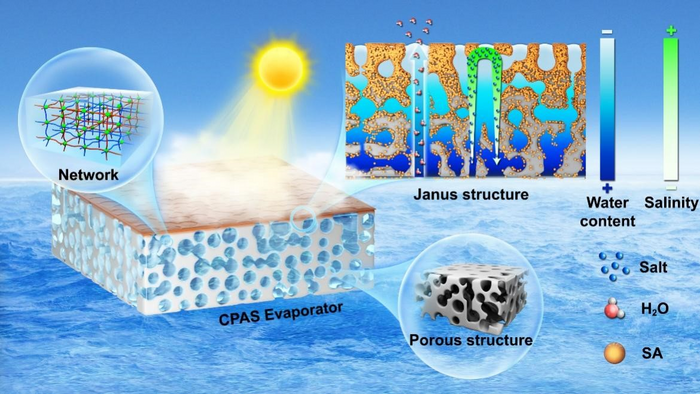Desalination is regarded as one of the most efficient solutions to address the growing worldwide shortage of freshwater supplies. However, there is a catch: to implement large-scale applications, effective and inexpensive evaporation materials are essential.
 Schematic diagram of the desalination and salt resistance mechanism of this Janus sponge-like hydrogel solar evaporator. Image Credit: Aqiang Chu
Schematic diagram of the desalination and salt resistance mechanism of this Janus sponge-like hydrogel solar evaporator. Image Credit: Aqiang Chu
Although conventional usage of hydrogels in interfacial solar evaporators still cannot meet the trade-off for high evaporation rate, salt resistance, and lasting mechanical qualities, they still provide a potential prospect.
Since industrial high-salinity wastewater requires long-term evaporation and treatment, most conventional hydrogel materials are only suited for low-salinity brine. It has been established that creating an interpenetrating 3D macropore structure can improve the salt resistance of hydrogels.
However, water transport that occurs quickly and a high-water content could result in more conductive heat loss. By further developing the Janus structure, this issue can be resolved. Although there are many ways to construct these kinds of structures, most of them are complicated and lack surface stability.
To achieve this, a study group from Hebei University of Technology in Tianjin, China, added hydrophobic fumed nano-silica aerogel (SA) to the hydrogel manufacturing process.
During the gelation process, SA can move and aggregate on its own to the upper region of the hydrogel, where it forms a Janus structure, thanks to its extreme lightness and extreme hydrophobic properties.
We know that the regulation of pore structure can also balance the problem of increased heat loss caused by the high salt resistance of the sponge-like hydrogel. Consequently, we incorporated agar (AG) to enhance the comprehensive performance of hydrogel evaporators.
Aqiang Chu, Study Lead Author, Hebei University of Technology
It is noteworthy that AG has a thickening effect that, in this situation, stabilizes the bubble structure created during the foaming process and aids in controlling the hydrogel’s pore structure.
Chu added, “The large number of hydroxyl groups on the AG chain can at once reduce the enthalpy of water evaporation by interacting with water and forming ether bonds with polyvinyl alcohol to form a robust cross-linked network, contributing to improved mechanical properties.”
Study corresponding author Hao Li stated, “Coupled with the low cost and environmental friendliness of these preparation materials, our Janus dual-network sponge-like hydrogel solar evaporator shows great potential for practical applications in the field of interfacial solar evaporation.”
Journal Reference:
Chu, A., et al. (2023) Biomass-enhanced Janus sponge-like hydrogel with salt resistance and high strength for efficient solar desalination. Green Energy & Environment. doi:10.1016/j.gee.2023.04.003.